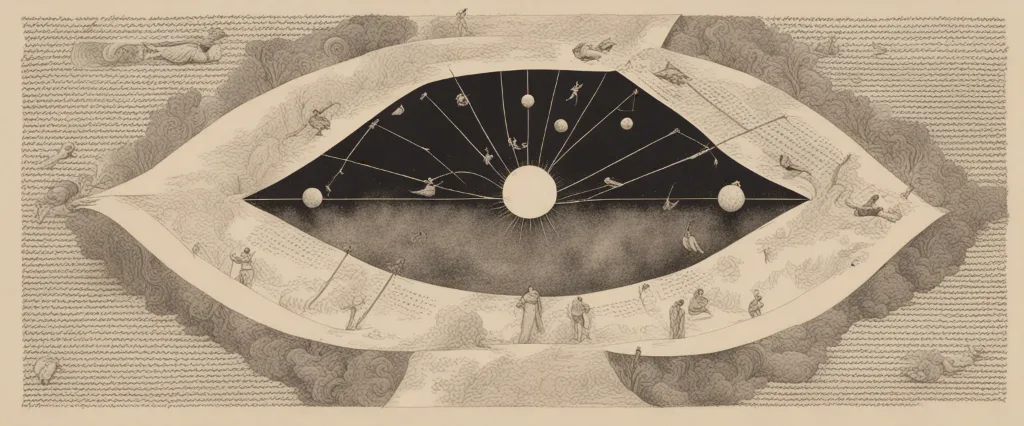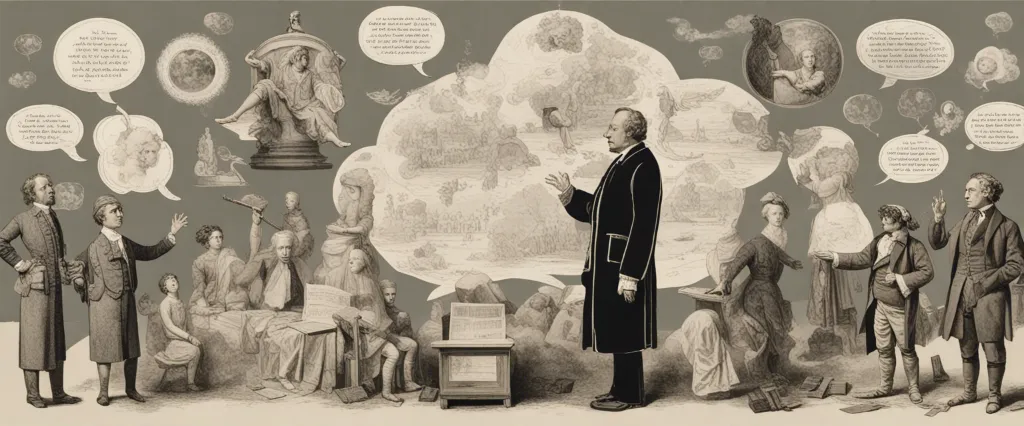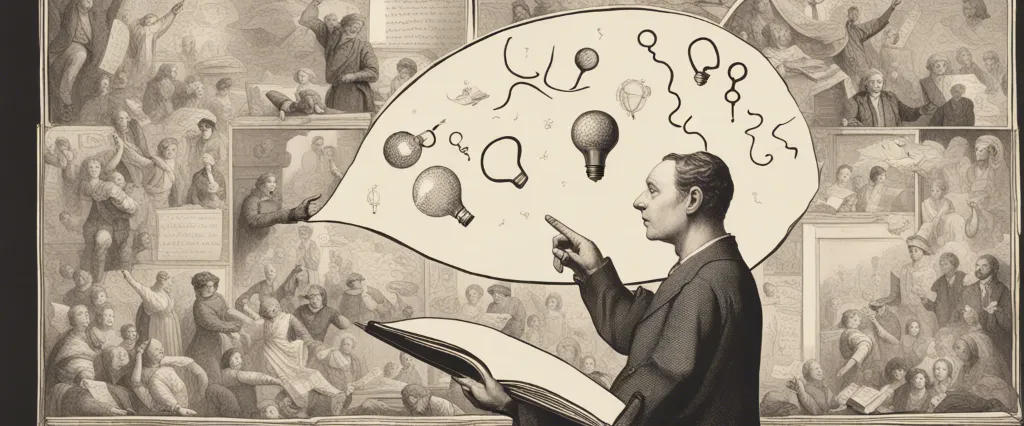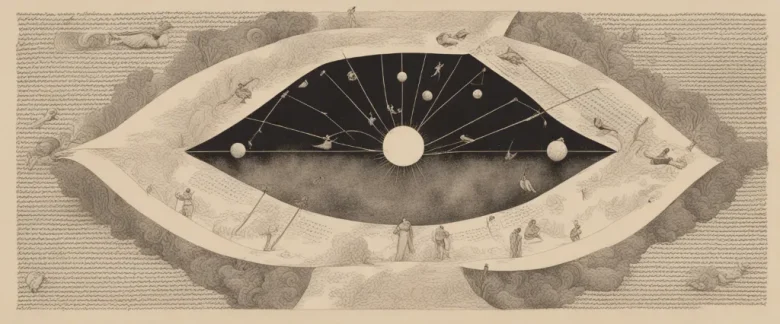
In “A Little History of the World,” E.H. Gombrich takes readers on an engaging journey through the vast tapestry of human history, offering a concise and accessible overview of the major events and civilizations that have shaped our world. Gombrich, born in Vienna in 1909, was a renowned art historian and writer. His passion for storytelling and his skill in making complex subjects understandable for all audiences shine through in this captivating historical account. Through vivid anecdotes and colorful descriptions, Gombrich invites readers of all ages to explore the intriguing twists and turns of human civilization, ultimately illuminating our shared heritage.
Chapter 1: The Beginnings of Human Civilization
Chapter 1: The Beginnings of Human Civilization introduces the reader to the early stages of human civilization. It starts by discussing the evolution of Homo sapiens and the development of humans as a species. The author then delves into the Paleolithic age, commonly known as the Stone Age, during which early humans relied on hunting and gathering for survival.
Gombrich describes the struggles and challenges faced by these early humans, including their constant movement in search of food and the use of tools made from stone, wood, and bone. He also explores the emergence of language and communication as crucial developments that led to the formation of small groups.
The chapter further explores the Neolithic age, a significant period characterized by the domestication of plants and animals. The author emphasizes that this transition from hunting and gathering to farming and herding transformed human existence. With the advent of agriculture, humans began to settle in one place, enabling the growth of permanent communities and the establishment of a more structured society. This, in turn, prompted the development of more complex technologies, such as pottery and weaving.
Gombrich also highlights the importance of storytelling and religion during this time, noting that they helped foster a shared culture and belief system within communities. He briefly touches on the construction of monumental buildings and the creation of art as signs of human progress and innovation.
In summary, Chapter 1 of A Little History of the World lays the foundation for understanding the early stages of human civilization. It explores the primitive struggles of early humans, their transition to settled life through agriculture, and the development of cultural and technological advancements that shaped human existence.
Chapter 2: Ancient Civilizations and Empires
Chapter 2 of “A Little History of the World” by E.H. Gombrich discusses ancient civilizations and empires. The chapter focuses on the early developments of human societies and the rise of civilization in different parts of the world.
Gombrich begins by describing the ancient Mesopotamian civilization, highlighting the importance of farming and the emergence of city-states such as Uruk. These city-states, he explains, were ruled by kings who controlled vast territories and established laws to regulate society.
Moving on, Gombrich explores the ancient Egyptian civilization, emphasizing the central role of the Nile River in their lives and the construction of colossal pyramids and temples. He also introduces the pharaohs, who were believed to be gods in human form and had absolute power over their subjects.
The chapter then delves into the Indus Valley civilization, which flourished in what is now modern-day Pakistan and northwestern India. Gombrich explains how the cities of Harappa and Mohenjo-Daro were remarkably advanced for their time, boasting sophisticated urban planning, plumbing systems, and public baths.
Next, the author explores the civilization of ancient China, focusing on the rise of the Shang Dynasty. Gombrich describes the strict social hierarchy, the invention of writing, and the early developments in bronze casting.
Finally, Gombrich briefly mentions the ancient Americas, highlighting the Mayan and Aztec civilizations. He mentions their achievements in astronomy, mathematics, and the creation of large, intricate cities.
Overall, Chapter 2 provides a broad overview of ancient civilizations and empires from Mesopotamia to the Americas. Through concise explanations, Gombrich introduces readers to the key features and contributions of these ancient cultures, laying the groundwork for further exploration in later chapters.
Chapter 3: The Classical World
In Chapter 3 of “A Little History of the World” by E.H. Gombrich, titled “The Classical World,” the author discusses the civilizations of ancient Greece and Rome. Gombrich emphasizes the importance of the Greeks in shaping the Western world and highlights the lasting influence of their philosophy, literature, and art.
The chapter starts by introducing the ancient Greeks, explaining their different city-states and how they were often at war with each other. Despite this, the Greeks shared a common identity and language that united them. Gombrich describes how the Greeks invented democracy and how it was an important concept in their society.
Next, the author explores Greek literature, focusing on Homer’s epic poems, the Iliad, and the Odyssey. Gombrich explains that these stories were central to Greek culture and were memorized and recited by bards for centuries. He also mentions other Greek playwrights, such as Aeschylus, Sophocles, and Euripides, and their famous tragedies, which explored themes of morality, fate, and the human condition.
Moving on to Greek philosophy, Gombrich introduces notable thinkers like Socrates, Plato, and Aristotle. He highlights their contributions to the understanding of ethics, politics, and the search for knowledge. The chapter also covers Greek architecture, notably the impressive temples of Athens, which embodied the ideals of harmony, symmetry, and balance.
The last part of the chapter transitions to the rise of Rome. Gombrich explains how Rome emerged as a republic, governed by elected officials, and later transformed into an empire. The author describes Roman engineering feats like the construction of roads, aqueducts, and the Colosseum.
Overall, Chapter 3 of “A Little History of the World” provides a concise overview of the important contributions that the classical world, particularly the Greeks and Romans, made to Western civilization in the areas of democracy, literature, philosophy, and architecture.
Chapter 4: The Middle Ages and Feudalism

Chapter 4 of A Little History of the World by E.H. Gombrich provides an overview of the Middle Ages and the system of feudalism. During this period, which lasted approximately from the 5th to the 15th century, the Western Roman Empire collapsed, leading to the emergence of new political and social structures.
Gombrich describes how, in the absence of a centralized government, the power and authority of local lords and knights increased. These nobles acquired lands and serfs, providing protection to the people in exchange for their loyalty and labor. This led to the development of feudalism, a hierarchical system where mutual obligations and duties were established between different levels of society.
The author explains that the feudal system was based on the principle of land ownership and the control of resources. At the top of the feudal structure was the king, who owned the most extensive lands and granted fiefs to his vassals – the nobles. In return, the vassals swore an oath of loyalty to the king and provided military service when necessary.
Beneath the nobility were the serfs, who were peasants bound to the land they worked on. They were obligated to provide a portion of their crops or labor to the lords in exchange for protection. Gombrich highlights that life for serfs was harsh, with limited freedoms and rights.
The chapter also discusses the role of the Church during the Middle Ages, emphasizing the power and influence of the Catholic Church in both religious and political affairs. The church provided stability, common beliefs, and education to the people.
Overall, Chapter 4 explores the rise of feudalism and its impact on medieval society, highlighting the concentration of power in the hands of the nobles and the struggles faced by the lower classes who were tied to the land.
Chapter 5: Renaissance and Reformation
Chapter 5 of A Little History of the World by E.H. Gombrich discusses the Renaissance and Reformation, two major movements that reshaped Europe during the 15th and 16th centuries.
The Renaissance, meaning “rebirth” in French, refers to the revival of interest in learning and the arts that occurred in Italy and later spread throughout Europe. Gombrich highlights the shift from medieval thinking to a more secular and human-centered worldview during this period. He describes how advancements in art, literature, and science during the Renaissance were inspired by the rediscovery of ancient Greek and Roman texts.
Gombrich explains the concept of the “Renaissance Man,” an individual who excels in multiple fields of study, exemplified by figures such as Leonardo da Vinci and Michelangelo. These thinkers embraced curiosity, questioning traditional beliefs, and championing human potential. The chapter also addresses the significant role of wealthy patrons in supporting the arts and fostering creativity.
Moving on to the Reformation, Gombrich discusses the religious revolution led by figures like Martin Luther and John Calvin. He explains how dissatisfaction with the Catholic Church’s practices, such as indulgences, sparked a desire for reform. Luther’s Ninety-Five Theses, which criticized church corruption, ignited a movement that questioned the Church’s authority and teachings.
Gombrich examines the religious wars and conflicts that ensued across Europe as Protestantism gained followers. The Reformation laid the foundation for the establishment of various Protestant denominations, including Lutheranism and Calvinism, signifying a significant departure from the central power of the Catholic Church.
In summary, Chapter 5 of A Little History of the World explores the transformative periods of the Renaissance and Reformation, expressing how these movements reshaped Europe through the promotion of secular knowledge, artistic expression, and the questioning of traditional religious authority.
Chapter 6: The Age of Exploration and Colonization
Chapter 6: The Age of Exploration and Colonization, in the book A Little History of the World by E.H. Gombrich, discusses the period between the 15th and 16th centuries when European powers embarked on voyages to explore unknown lands and establish colonies in different parts of the world.
Gombrich starts by explaining that this period was motivated by several factors, including the search for new trade routes to Asia, the desire for new sources of wealth, and the spread of Christianity. These impulses were mainly driven by the Portuguese and Spanish, who took the lead in exploration during this era.
The chapter highlights the contributions of famous explorers like Christopher Columbus, Vasco da Gama, and Ferdinand Magellan. Columbus, sponsored by Spain, famously believed he had reached Asia when he landed in the Americas in 1492. Da Gama successfully sailed around the Cape of Good Hope and reached India, opening up a lucrative trade route for Portugal. Magellan’s expedition became the first to circumnavigate the globe, although he himself did not complete the journey.
As European explorers encountered new lands and peoples, they also brought diseases, weapons, and attitudes that had a disastrous impact on indigenous populations. Gombrich addresses the ethical implications of colonialism and how it shaped the power dynamics of the world.
The chapter concludes by noting that the Age of Exploration and Colonization set the stage for further European domination, as other nations, such as the Dutch, French, and English, sought their own colonies. This period of expansion marked a significant turning point in history, accelerating globalization and the interconnectedness of cultures throughout the world.
Overall, Chapter 6 provides a concise overview of the exploration and colonization efforts of European powers during the 15th and 16th centuries, shedding light on the motivations, consequences, and implications of this pivotal historical era.
Chapter 7: The Enlightenment and Scientific Revolution
Chapter 7 of “A Little History of the World” by E.H. Gombrich discusses the Enlightenment and Scientific Revolution, two significant intellectual movements that shaped Europe’s history and left a lasting impact on society, science, and philosophy.
The chapter begins by exploring the cultural and intellectual climate of the 17th and 18th centuries, which was characterized by a growing emphasis on reason, skepticism towards traditional beliefs, and a desire to pursue knowledge through observation and experimentation. Gombrich introduces key figures of the scientific revolution, such as Galileo Galilei, Isaac Newton, and Francis Bacon, who challenged the prevailing ideas of the time and laid the foundations for modern science. Their works revolutionized the understanding of the physical world and set the stage for the Enlightenment.
The Enlightenment, also known as the Age of Reason, emphasized human reason, individualism, and a strong belief in progress and societal improvement. Gombrich highlights the ideas of influential philosophers like John Locke, Jean-Jacques Rousseau, and Voltaire, who questioned the divine right of kings, advocated for individual liberties and democracy, and called for the separation of church and state.
Furthermore, the chapter also touches upon the burgeoning field of economics and Adam Smith’s influential book, “The Wealth of Nations.” Smith argued for free-market capitalism and the belief that the pursuit of self-interest could benefit society as a whole.
Towards the end of the chapter, Gombrich reflects on the legacy of the Enlightenment, emphasizing the profound impact it had on shaping the modern world. The scientific revolution and the ideas of the Enlightenment laid the groundwork for the Industrial Revolution, the spread of democracy, and the concept of human rights.
In conclusion, Chapter 7 of “A Little History of the World” delves into the Enlightenment and Scientific Revolution, highlighting the radical departure from traditional beliefs and the rise of reason, individualism, and scientific inquiry. It draws attention to the key thinkers of the time and their contributions to science, economics, and philosophy, ultimately shaping the world as we know it today.

Chapter 8: Modern Times and Globalization
Chapter 8 of “A Little History of the World” by E.H. Gombrich focuses on the period of Modern Times and the process of globalization. This chapter spans from the 16th century to the present day, highlighting key events and changes that have shaped our world.
Gombrich emphasizes that the modern era brought significant shifts in how people viewed the world and conducted themselves. He discusses the Scientific Revolution, starting with Nicolaus Copernicus challenging the old belief of an Earth-centric universe and introducing the heliocentric theory. This led to further scientific advancements, such as Galileo’s telescopic observations and Isaac Newton’s laws of motion.
The chapter also addresses the impact of the Enlightenment, an intellectual movement that valued reason, individualism, and progress. The ideas of philosophers like John Locke, Voltaire, and Jean-Jacques Rousseau challenged traditional authority and advocated for individual rights, religious tolerance, and democratic governance.
Global exploration and colonization played a crucial role in modern times, with European powers expanding their influence around the world through colonization and trade. This led to an exchange of goods, ideas, and cultures between different regions, known as globalization. Gombrich discusses the consequences of this process, including the exploitation of indigenous peoples, the emergence of the slave trade, and the rise of capitalism.
Gombrich also delves into the Age of Revolution, where major political changes occurred, such as the American and French Revolutions. He addresses the Industrial Revolution and its profound impact on society, as well as the subsequent rise of urbanization and the working-class movement. The chapter concludes with the World Wars, the struggles of the Cold War, and the ongoing pursuit of global cooperation.
Overall, Chapter 8 of “A Little History of the World” provides a concise overview of the modern era, highlighting pivotal events, intellectual movements, and the transformative power of globalization on society.
After Reading
In conclusion, E.H. Gombrich’s “A Little History of the World” provides readers with a captivating and accessible overview of human civilization from prehistoric times to the early 20th century. Through engaging storytelling and vivid descriptions, Gombrich chronicles the major historical events and developments that have shaped our world, while also exploring the triumphs and tragedies that define the human experience. With its concise yet comprehensive approach, this book serves as an excellent introduction to history for readers of all ages, fostering a deeper appreciation and understanding of our shared past. Gombrich’s ability to weave together complex concepts and narratives in a clear and engaging manner truly makes “A Little History of the World” a valuable resource for those looking to expand their knowledge of the world’s history.
1. Sapiens: A Brief History of Humankind” by Yuval Noah Harari: This book explores the history of the human species, from the emergence of Homo sapiens to the present day. Harari offers a thought-provoking and comprehensive analysis, discussing the impact of cognitive revolution, agricultural revolution, and scientific advancements. Similar to “A Little History of the World,” it provides readers with a big picture understanding of our shared history.
2. “1491: New Revelations of the Americas Before Columbus” by Charles C. Mann: Mann challenges conventional historical narratives by shedding light on the vibrant and complex societies existing in the Americas prior to Columbus’ arrival. Through extensive research, he presents a fascinating account of the indigenous civilizations, their advanced technologies, and the environmental impact of European colonization. This book expands on the exploration of global history, complementing “Guns, Germs, and Steel.”
3. The Emperor of All Maladies: A Biography of Cancer” by Siddhartha Mukherjee: This Pulitzer Prize-winning book delves into the captivating and often tragic history of cancer. Mukherjee combines scientific knowledge with narrative storytelling, tracing the disease’s origins, treatments, and social impact. “Countdown 1945” focuses on an important event in world history, and “The Emperor of All Maladies” similarly explores a significant topic in medical and social history, making it a compelling choice.
4. A Short History of Nearly Everything” by Bill Bryson: Bryson manages to present a wide-ranging overview of scientific discoveries and the key figures who contributed to our understanding of the natural world. From the origins of the universe to the complexities of quantum physics, he effortlessly connects various disciplines in an engaging and accessible manner. This book provides a different lens through which to explore history, complementing the themes found in “A Little History of the World.”
5. “The Swerve: How the World Became Modern” by Stephen Greenblatt: Greenblatt recreates the journey of an ancient manuscript, Lucretius’ “On the Nature of Things,” and explores its profound influence on the Renaissance and the subsequent development of modern thought. The book explores the power of ideas and the transformative nature of knowledge, paralleling the exploration of philosophical and intellectual history found in “A History of God” by Karen Armstrong.



